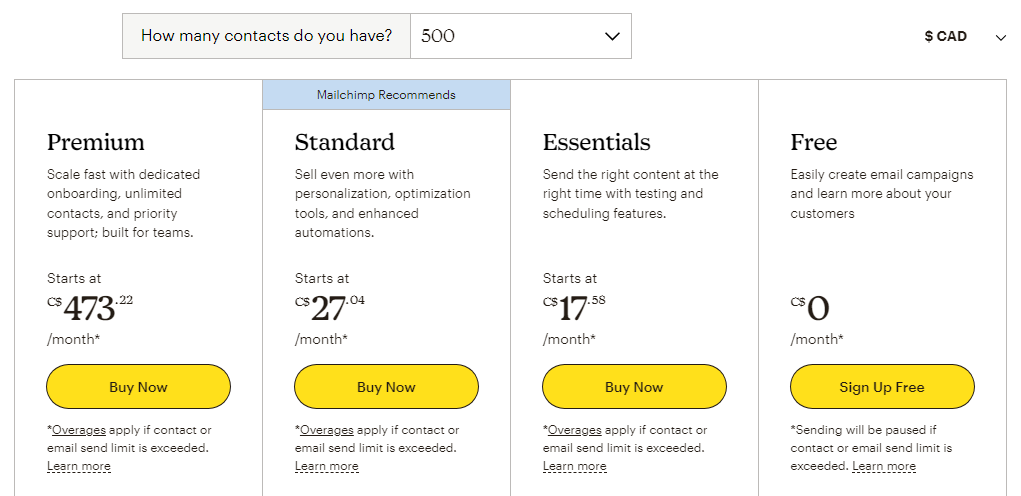The Unwavering Presence of Email Marketing
In the ever-changing world of digital marketing, email marketing stands as a constant, even in 2023. Its ability to adapt, engage, and deliver makes it an indispensable tool for businesses. This article delves into the multifaceted aspects of email marketing that contribute to its enduring relevance.
You may not realize it, but email marketing drives a higher ROI for businesses than any other channel. Studies have found that the average email marketing campaign makes $36 for every $1 spent.
That’s why, even though TikTok and Reels take up a lot of attention, email remains the king of connection in 2023. Here’s why email marketing is an indispensable tool for your business.
Section I: What email marketing does better than any other channel
1. Direct Communication with Your Customers
One of the best things about email marketing is its ability to communicate directly with your customers. It’s more than just sending messages; it’s about creating meaningful connections. By reaching your audience in their inbox, you can foster a personal relationship that goes beyond just ads.
The best part is, as you communicate with your customers and build a relationship with them, you don’t just develop their brand loyalty. You also gain immediate feedback on their needs and preferences that you can use to tailor future offers, messages, and products down the road.
2. A Cost-Effective Approach
For many companies, marketing budgets are pretty tight right now. That makes email marketing a huge win as a cost-effective solution. Its ability to yield high returns on investment without draining resources makes it a go-to strategy for businesses of all sizes. From small startups to large corporations, email marketing offers a scalable solution that fits various budget constraints, making it an attractive option for all.
For small businesses, some common options are:
- Mailchimp
- Constant Contact
- Klaviyo
- ActiveCampaign
Most of these options have scaling prices based on how many subscribers are on your email list. That means that small businesses can pay very little, and as they grow their bill will increase slowly over time.
Here’s a look at Mailchimp’s current pricing for 500 contacts:
Enterprise-level corporations are more likely to use custom email marketing solutions, or choices like Salesforce, Marketo, or SendGrid.
More complex email solutions allow for largers lists and more customization. They also feature stronger integrations with CMS systems. Prices can quickly approach tens of thousands of dollars per month or more.
3. Instant Adaptability to Market Changes
The digital landscape is ever-changing, and email marketing’s adaptability is one of its strongest suits. Its flexibility allows businesses to tailor campaigns to fit various needs, ensuring that the message always hits the mark.
Imagine that you arranged a radio or television advertising campaign. It wouldn’t be uncommon to have a multi-month commitment, with significant costs involved. When brands have to suddenly stop television ad campaigns, it’s an expensive (and public) decision.
With email campaigns, companies can almost instantly pivot, adapt, or change to sudden needs, like stock shortages, price increases, or sales opportunities.
Whether it’s a seasonal promotion or a response to a sudden market shift, email marketing can quickly adapt to meet the demands of the moment.
4. Personalization and Segmentation
Personalization is no longer a luxury; it’s a necessity. Email marketing’s ability to segment audiences and personalize content ensures that each recipient is more likely to receive an offer or messaging that resonates with them and prompts them to action.
This targeted approach enhances engagement and fosters loyalty. Some easy examples of targeted personalization might be:
Coupons for a customer’s birthday
Discounts on local events near them
Recommended products based on their purchase history
By understanding customer behavior and preferences, businesses can create personalized experiences that resonate with individual recipients, leading to higher conversion rates.
Section II: Advanced Strategies in Email Marketing
Now that we’ve got a basic handle on why you should be doing email marketing (no matter what type of business you have) let’s talk about some advanced email marketing strategies you may not have seen anywhere else.
1. Integrate Your Emails with Other Marketing Channels
Email marketing doesn’t work in isolation; it’s part of a bigger picture. Its seamless integration with other marketing channels creates a cohesive and comprehensive marketing strategy that amplifies success. Whether it’s social media, content marketing, or SEO, email marketing acts as a unifying force that brings all elements together, creating a harmonious and effective marketing ecosystem.
What does that mean? Don’t think of your marketing channels in isolation. They’re all just different ways of connecting with your customers, which means that your messaging needs to relate and reinforce your value statements across different channels.
For example, if you send a customer to your website through an email campaign, and they don’t make a purchase, your retargeting campaign on Facebook can share the same visuals or messaging for familiarity and continuity. This builds your brand and makes for more effective conversions.
2. Analytics and Insights
Data drives decisions, and email marketing provides marketing with a wide range of analytical data they can use to help increase sales. From open rates to conversion metrics, the insights gleaned from email campaigns guide future strategies and optimize performance.
When Apple launched iOS 15, it included a Mail Privacy Protection feature that allowed users to opt out of sending open rates back to brands. This has drastically changed how email marketers use analytics to judge the success of their campaigns.
Instead, marketers now rely on a range of other metrics, perhaps the most useful of which is click-through rate and onsite conversions.
These analytics offer a detailed view of customer behavior, campaign effectiveness, and areas for improvement, allowing businesses to make informed decisions that enhance success.
3. Compliance with Regulations
Is your list built with a double opt-in? If you’re not sure, you may want to pay more attention to regulation compliance.
Right now, privacy is a top concern for many of your customers (which is a change from even 5 years ago.) Canada, the USA, and the EU all have different legal regulations that govern how email marketing can function in their jurisdiction.
- Canada is governed by CASL
- The United States is governed by CAN-SPAM
- The European Union is governed by GDPR
Note that you must follow the regulations of the jurisdiction where your subscriber lives, not where your business is based.
Following these regulations closely isn’t just a requirement. It also builds trust with your customers.
By respecting privacy laws and offering transparent opt-in and opt-out options, you will demonstrate integrity and responsibility, strengthening customer trust and loyalty.
4. Build Long-Term Relationships
Beyond sales and promotions, email marketing is about nurturing relationships. It’s a platform for ongoing engagement that turns casual subscribers into loyal customers.
Not every customer is ready to buy when you’d like them to. In fact, 95% of prospects who might want to buy your product probably aren’t ready to buy it right now. This is called the 95/5 rule.
That’s ok. It just means that you need to find a way to stay top-of-mind so that when they are ready to buy, you’re the company or brand they think of first.
Through consistent communication, valuable content, and responsive interaction, email marketing is an easy and inexpensive way to build long-term relationships with prospects and customers that extend beyond a single transaction.
5. Automation and Efficiency
Time is money, and automation saves both. Email marketing’s automation capabilities ensure timely communication without sacrificing personalization.
From automated welcome emails to triggered responses based on customer behavior, automation streamlines processes, making email marketing more efficient and effective.
Section III: The Future of Email Marketing
We’ve established that email marketing is a valuable channel in 2023, and we’ve shared some advanced techniques for improving your email marketing.
But how viable will email marketing remain in the future? Or will it be replaced by other ways of marketing? Do young people even read their emails anymore?
Let’s take a look at why we think email marketing has a strong future in front of it.
1. Embracing New Technologies
As technology evolves, so does email marketing. From AI-driven content to interactive elements, the future of email marketing is full of opportunities. As a marketer or business owner, making sure you stay ahead of the curve will ensure your continued success.
In fact, 43% of marketers who are already using generative AI use it to help with email marketing. That could mean a little inspiration for graphics or some AI-written copy. Just make sure a human edits it before you send it to your customers.
Integrating these new technologies as they become available will make sure that your email marketing engagement stays high and remains an effective channel over time.
2. Sustainability and Social Responsibility
In a socially conscious world, email marketing offers a green alternative to traditional advertising like direct mail (which the US postal service estimates accounts for 1/10th of a percent of all energy use in the USA). Its digital nature aligns with the sustainability goals of your business and your customers, making it a responsible choice.
By reducing paper waste and energy consumption, email marketing contributes to a greener planet, aligning with the values of environmentally conscious consumers.
3. Global Reach and Localization
Email marketing’s global reach doesn’t diminish its local appeal. Its ability to cater to diverse audiences while maintaining local relevance makes it a truly universal tool. By understanding cultural nuances and local market trends, email marketing can create globally appealing campaigns that still resonate on a local level.
When you collect emails, try to also collect geographic data. Some email marketing tools also offer geolocation estimates based on the IP addresses of your subscribers. You can then segment your audience and apply local cultural or financial specificity to your campaigns in a way that you can’t with some other marketing channels.
Conclusion
Email marketing continues to prove to be a dynamic and indispensable tool in the digital marketing arsenal. Its enduring utility lies in its ability to forge personal connections, adapt to market changes, integrate with other channels, and embrace new technologies.
Whether you’re a small business looking to grow or a multinational corporation aiming to sustain your reach, email marketing offers a tailored solution that resonates with diverse audiences.
Email marketing is cost-effective, easy to customize or segment, and has a great ROI. That’s why we think that email marketing in 2023 is not just surviving; it’s thriving.
Join the Alacrity Academy Learning Hub for more discussion and resources


